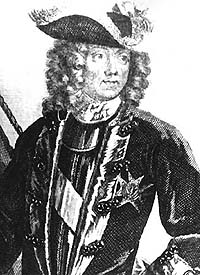Nicolas Chalon du Blé
Nicolas Chalon du Blé | |
|---|---|
| Marquis of Uxelles and Cormatin | |
 | |
| Born | 24 January 1652 Chalon-sur-Saône, France |
| Died | 10 April 1730 (aged 78) Paris, France |
| Father | Louis Chalon du Blé, Marquis of Uxelles |
| Mother | Marie Le Bailleul |
| Military career | |
| Allegiance | |
| Rank | Marshal of France |
| Wars | |
| Awards | |
Nicolas Chalon du Blé,
Biography
Early years
du Blé was born at Chalon-sur-Saône.
His appearance was described as tall and ruddy, with a huge wig and a hat pulled down over his eyes. He tended to hide his military orders and decorations under a plain, tightly buttoned coat.[1]
Second son of Louis Chalon du Blé, marquis of
Military career

He was granted military leadership in 1688, during the Nine Years' War; he served as
He initially defended during the
Diplomatic career
He took part as a diplomat at the preliminary conferences of Geertruidenberg on 9 March 1710, but the peace negotiations were broken by Louis XIV at the end of the following June. Chalon du Blé again represented the king during the negotiation for the Peace of Utrecht in 1713.
He was one of the aristocratic architects of the polysynody system of government, and obtained the first presidency of the Council of Foreign Affairs, (1715–1718) when the regency of Philippe II began. This appointment was made against the better judgement of the Regent, who held different foreign policy aims than Blé, and who had been the target of scorn from Blé's social circle. The Regent made the decision primarily to keep his enemy in plain view rather than in subterfuge against the government.
As president of the Council of Foreign Affairs, Blé tended to the popular, traditional French view of favoring Catholic Spain over Protestant Great Britain. This was in contradiction to the Regent, who admired Britain's
Nicolas Chalon du Blé was one of the most notable homosexuals of his age, known for his attraction to young valets as well as aspiring officers whom he "domesticated".[1][2] He died in Paris in 1730.
References
